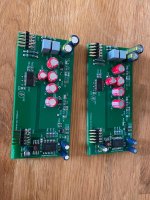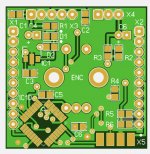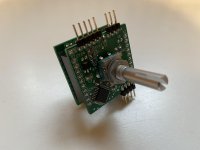Either way, reading all the posts, it doesn't sadly seem simple (= no display, no polluting electronic) and is likely to be expensive at the end... not due to the chip, but the extras needed.
It would be nice to have a complete fail safe proposal for less than 50E... perhaps I got it all wrong with the knob feeling and "children safe position reading"... perhaps no knob at all, ie remore control only is the (childen) safest while also the cost effective solution after all...
Claude
It would be nice to have a complete fail safe proposal for less than 50E... perhaps I got it all wrong with the knob feeling and "children safe position reading"... perhaps no knob at all, ie remore control only is the (childen) safest while also the cost effective solution after all...
Claude
A stepped "make-before-break" attenuator would be a better choice I guess. You don't want any noise/crackling to have influence on the output level.
That would defy one of Muses advantage points: fine volume control. I suppose one capacitor at potentiometer viper would solve any noise and crackling issues. Even some delay in volume change due big capacitor, after potentiometer position change, wouldn’t be a problem.
tombo56 -
What size are the smd resistors and transistors on your EM14 to Muses adapter board,
if I may ask?. SOT-23 or other? Nice little board, by the way.
What size are the smd resistors and transistors on your EM14 to Muses adapter board,
if I may ask?. SOT-23 or other? Nice little board, by the way.
Resistors are 0805, same as on the Muses board. Transistors are SOT-23. Any NPN transistor would do. It doesn’t have to be BC817.
That would defy one of Muses advantage points: fine volume control. I suppose one capacitor at potentiometer viper would solve any noise and crackling issues. Even some delay in volume change due big capacitor, after potentiometer position change, wouldn’t be a problem.
A capacitor is not enough I think but you are right that "fine" would don't be the best description 🙂 A course and an added stepped attenuator for fine adjustment would solve it but at the expense of complexity.
Hi Meldano
Any further news on
BTW: Actually I build a new controller board with a STM32 and many features like conventional pot, programmable steps, optional input channel switching, Muses 72320 or 72323 option...
Very interested in the new 72323
Any further news on
BTW: Actually I build a new controller board with a STM32 and many features like conventional pot, programmable steps, optional input channel switching, Muses 72320 or 72323 option...
Very interested in the new 72323
Hi,
the 72323 did a good job in my main system.
I'm currently waiting for the new controller boards to be delivered.
I think the software will be ready in 1-2 months.
the 72323 did a good job in my main system.
I'm currently waiting for the new controller boards to be delivered.
I think the software will be ready in 1-2 months.
Attachments
Can't wait till you have it ready!
Is there an input selector incorporated? If not I'm proceeding with the one I'm working on right now.
Regards
Is there an input selector incorporated? If not I'm proceeding with the one I'm working on right now.
Regards
The PSU in the manual was only for testing (LM317/337).
Pass Labs use the NJR 78/78
I tested the NJR, LM317/337, LT3045/3094, TPS7A49/TPS7A30
In my main system (Pass clone) I prefer the TPS types.
My college prefer in the same Preamp the NJR.
Meldano do you have a link to a NJR regulator?
Features list for v2.0
• Mech. compatible to v1
• modern mcu (stm32)
• Infrared learning capabilities
• 0..-111,75dB in steps of 0,25/0,5/1/2dB
• Mute function
• Individually adjustable user parameter (volume step size, startup volume, balance, no. of input channels…)
• Balance
• +/-10…18V voltage supply
• 2,4,6,8 volume channels possible because volume boards can be cascaded
• optional 1..4 input channel
• optional analog potentiometer to adjust volume
• reduce distortion from mcu with deep sleep mode
2/3 of features are ready/tested. Documentation is “on the way”
I think I need around 2 month to complete the firmware. After that I will order a couple of boards.
I have only 5 kits of version 1 (for a special price) left.
• Mech. compatible to v1
• modern mcu (stm32)
• Infrared learning capabilities
• 0..-111,75dB in steps of 0,25/0,5/1/2dB
• Mute function
• Individually adjustable user parameter (volume step size, startup volume, balance, no. of input channels…)
• Balance
• +/-10…18V voltage supply
• 2,4,6,8 volume channels possible because volume boards can be cascaded
• optional 1..4 input channel
• optional analog potentiometer to adjust volume
• reduce distortion from mcu with deep sleep mode
2/3 of features are ready/tested. Documentation is “on the way”
I think I need around 2 month to complete the firmware. After that I will order a couple of boards.
I have only 5 kits of version 1 (for a special price) left.
Main improvements: Muses72323, Software
Other: Yes, steps, adjustable parameter, optional relay input selector.
Other: Yes, steps, adjustable parameter, optional relay input selector.
Coooool 🙂
I still have the V1 to populate....many homeworks to do this winter ! Will have a look on the V2 if needed too.
Many thanks for sharing.
I still have the V1 to populate....many homeworks to do this winter ! Will have a look on the V2 if needed too.
Many thanks for sharing.
Whaou Meldano, that looks great and provided the price is right you have a winner here!
Frohe Weihnachten
Claude
Frohe Weihnachten
Claude
- Home
- Source & Line
- Analog Line Level
- MUSES 72320 electronic volume



